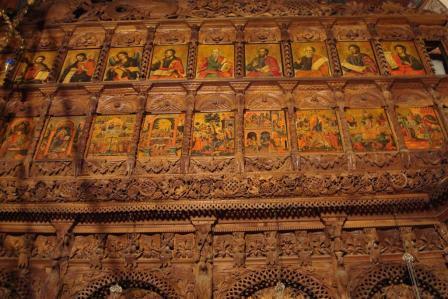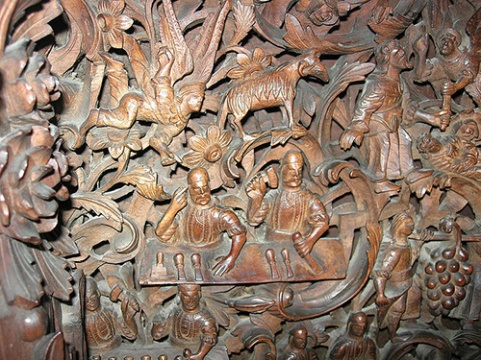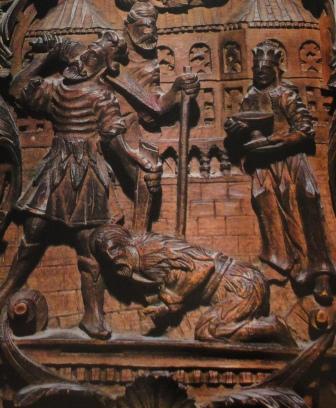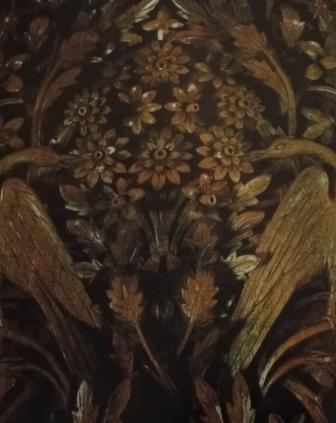
Woodcarving is an art that has been telling stories for centuries. Every moment spent, every move with the chisel to create this art has its own special meaning. Filled with love and emotions trough the hands of the woodcarver every piece of wood comes alive conveying how important the heritage is.
It’s not only the beauty of the woodcarvings that will leave you breathless, it’s also the fascination that will take over your senses and will fill you with positive energy. Especially when you ponder how long it takes and how much effort is necessary for something like that to be created.
There are families that pass this craft through generations and creating masterpieces for centuries. It seems that the spirit of the past merges with the contemporary touch and the results will surely amaze you.
In this post I would like to introduce you to this artistic expression and tell a few words about the places where you can enjoy its beauty.
Although the woodcarvings are hard to protect, unlike the stone or metal, there are very well preserved old pieces that can be seen mostly in churches and monasteries. Besides the churches, the woodcarvings were created as decorations of mosques, houses of wealthy people, as well as sarays.
One of the oldest and priceless artworks can be found in Ohrid. A sculptural representation of St. Clement of Ohrid that dates back to the end of the XIII / beginning of the XIV century can be viewed in the Icon Gallery. The most recent researches indicate that the sculpture was created by a local craftsman using older figures as models.

The single door of the church of St. Nicholas Bolnicki is also one of those old wood carved masterpieces. The oldest doors of this kind in the Balkans are the doors of the monastery Panagios Mavriptis in Kastoria, dating between the XI and the XII century and the doors of the monastery of Olimpiotis in Thessalia, made in 1296. The Ohrid doors belong to the period of the XIV century, as do the doors of the Hreljova church in Rilski Manastir in Bulgaria. The latest researches on the door has demonstrated that it has unique composition and distribution of motifs with Eastern and Byzantine origin.
The most famous wood carving artworks in Macedonia are the iconostases. The oldest wood carved iconostasis in Macedonia can be found in the little church of Small St. Diviners in the old part of Ohrid (Church St. Kuzman and Damjan) which dates from XIV century.
In Macedonia one can also come across of iconostases from the XVII century, but they are modest. Examplas can be found in the monasteries of Karpin, Poloski and Slepce, near Demir Hisar, as well as in the monastery church of St. Nicholas in Slepce monastery nearby Prilep. In addition to the iconostases, other objects as large crosses for the upper parts of the iconostasis were carved in this period.
The art of carving in Macedonia during the XVIII century was under big influence of Italian baroque art which was spread from the Holy Mount of Athos, Greece, through the rest of the Balkans. The iconostasis in the monastery of St. Naum in Ohrid represents a major artistic achievement from the beginning of the XVIII century. In this period the carved shapes begin to assume a three-dimensional aspect. (Deep wood carving.) Stage of the evolution of the carver’s art – openwork carving. Other example of this kind can be seen in the church of St. Demetrius in Bitola.

With the rise of the Macedonian identity in the first decades of the XIX century, a rise in the field of artistic creation, as well of the woodcarving, was also felt. The large iconostases in the cathedral churches built in Macedonia during this period requested the employment of several master carvers. It more often happened that teams were formed from all crafts, which would than together take on the complete work of a given church.
Petre Filipovski “Garka”, his brother Marko and Makarie Frckovski from the village Galicnik created the iconostasis in the Monastery St. John the Baptist and in the church of the Holy Savior. Their team of carvers was also doing woodcarving in the mansions of the beys in Macedonia and Prizren (Kosovo) and its surroundings.
The monastery St. John the Baptist is a place worth visiting. The wood carved iconostasis created in the period from 1830 to 1840, is a grandiose example of Macedonian wood carving. As usual, the crafters left behind self-portraits as their signature among the scenes of the old and new testimony.



The same crafters worked on the iconostasis of church Holy Savior in Skopje from 1824 to 1829 – an iconostasis that is ten meters long and six meters high. It’s interesting to see that some of the characters in the Biblical scenes are depicted dressed in Galicnik folk costumes. (of the birthplace of the crafters).

That was the spectacular journey of wood-carving in Macedonia. At the end of XIX and the beginning of the XX century, the wood-carving entered its twilight period.
This rare and exceptional craft still continues in some Macedonian families. More about that in Part 2.
At the end I want to say that we are lucky to be able to see many of this master pieces and I hope you will have the opportunity to visit at least some of them. Enjoy in the photos that follow.






The photographs are borrowed from “Macedonian Wood-carving” by Dimitar Cornakov.
Daily prompt: Carve
just amazing….thanks for sharing….
LikeLiked by 2 people
thank you… other parts will follow
LikeLiked by 1 person
OK Vesna….regards….
LikeLiked by 1 person
What beautiful art! So detailed, it’s hard to imagine people with so much talent.
LikeLiked by 1 person
Unfortunately less and less people doing it nowadays, I will write about some of the families that still practice this art.
LikeLiked by 1 person
It would be wonderful to read about the people 👍
LikeLiked by 1 person
Great! Beautiful! Inspiring! I have seen the iconostasis in St. Naum. Thank you Vesna!
LikeLiked by 2 people
I’m glad you like it, thank you
LikeLiked by 1 person
Woodcarving on furniture is very beautiful. Unfortunately, this is a dying trade with less and fewer people doing it.
LikeLiked by 2 people
Yes it’s too bad. Thank you for your comment.
LikeLike
Wow! I seriously admire such beautiful craftsmanship! Just beautiful. Lots of great information thank you for sharing. I always love to learn new things. 🙂
LikeLiked by 2 people
Thank you for your kind words.
LikeLike
Great photos, I’d love to see some of these in person.
LikeLiked by 1 person
Thanks, they are much more beautiful in person.
LikeLike
Wow, it’s great that so much of it survived! I hadn’t realised there was woodcarving art in this style in Macedonia – some of the swirling vegetation motifs look very Southeast Asian!
LikeLike
It’s probably because of the geostrategical position of Macedonian, located in the center of the Balkans and many roads were leading trough it’s territory. People were traveling and trading, that way so much was brought here from different parts of the world. Thank you for sharing the information, I didn’t know it’s so similar.
LikeLiked by 1 person
Wood carving is an art very few know of and very few of them practice it as well. I am glad to learn so many new things about wood carving from your post. Personally, I am not very sure if I am interested in visiting all these sites and admire the work, but I might try visiting one of these. St. John monastery’s pictures look very promising to me. Great photographs.
LikeLiked by 1 person
St. John monastery is definitely a place to be, I’m sure you will like it. I’m preparing a new posts about some of the families that practice this art. Thank you for your visit.
LikeLike
I love seeing wood carvings, especially in Churches. Its a craft that has slowly dimensioned which is sad. Thank you for putting it in the spotlight.
LikeLiked by 1 person
I’m hoping this way we will remind the people about the beauty and extraordinarily of this art. Thank you for your visit.
LikeLike
Reblogged this on Alessandria today.
LikeLiked by 1 person
Thank you, I appreciate it
LikeLike